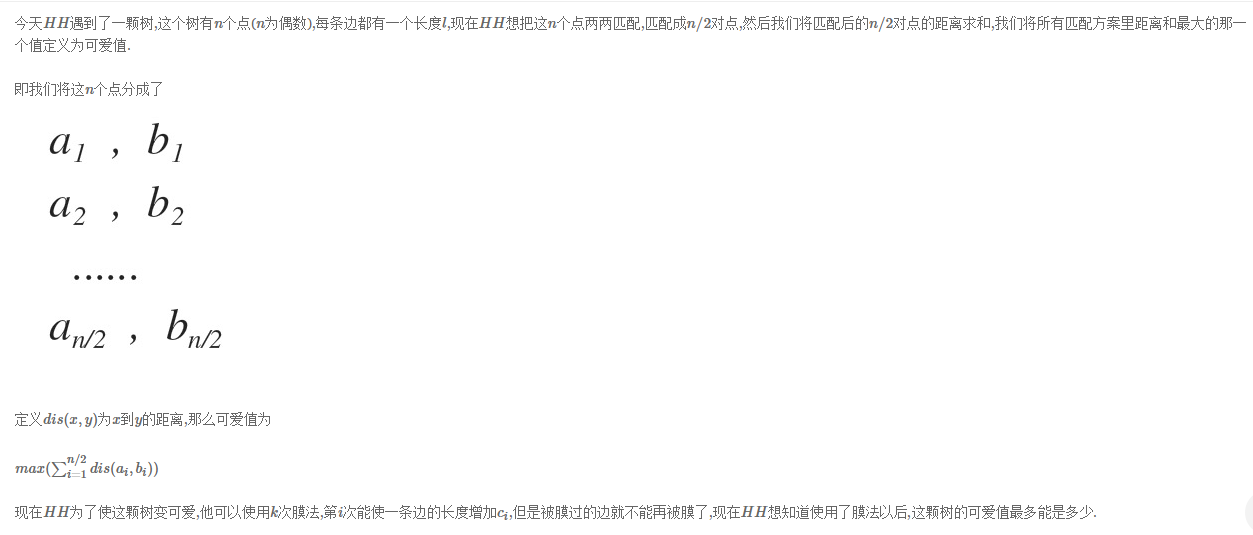“玲珑杯”ACM比赛 Round #18--最后你还是AK了(搜索+思维)

OUTPUT

SAMPLE INPUT
1
4 2
1 2 5
2 3 5
3 4 5
5 5
SAMPLE OUTPUT
35
HINT
对于样例,我们将1和4匹配,2和3匹配,然后对2和3之间的边使用膜法,对3和4之间的边使用魔法
若出现爆栈问题,改栈方法请参考1093题目代码
1093地址:http://www.ifrog.cc/acm/problem/1093
代码地址:http://ideone.com/Wk24ET
思路:官方题解:

我的理解:其实每条边上的值的大小并不影响点的匹配,对于任意一条边来说,对应一个父节点和孩子节点,令以这个孩子为根节点的子树包含的节点数为 t,总节点数位 n,我们应该尽量使子树上的点都过这条边去和子树以外的点匹配,所以过该边的最大点对数为min(t,n-t), 所以ans+=min(t,n-t)*w ,可以利用树上搜索得到该树的最大可爱值,对于k次使用魔法,可以对每条边进过的次数进行排序,贪心的吧增量大用得到进过次数多的边上即可。
代码如下:
#define OPENSTACK #include <iostream> #include <algorithm> #include <cstdio> #include <cstring> #include <vector> using namespace std; typedef long long LL; const int maxn=1e5+5; vector<pair<int,int> > v[maxn]; int c[maxn], cn[maxn], tmp, n; LL ans; int dfs(int p,int f) { int count=0; for(int i=0; i<v[p].size(); i++) { pair<int,int>pa=v[p][i]; if(pa.first==f) continue; int t=dfs(pa.first,p); cn[tmp]=min(t,n-t); ans+=(LL)cn[tmp]*(LL)pa.second; tmp++; count+=t; } return count+1; } int main() { #ifdef OPENSTACK long long size = 64 << 20; // 64MB char *p = (char*)malloc(size) + size; #if (defined _WIN64) or (defined __unix) __asm__("movq %0, %%rsp\n" :: "r"(p)); #else __asm__("movl %0, %%esp\n" :: "r"(p)); #endif #endif int T,k; cin>>T; while(T--) { for(int i=0;i<maxn;i++) v[i].clear(); scanf("%d%d",&n,&k); for(int i=1;i<n;i++) { int u1,u2,w; scanf("%d%d%d",&u1,&u2,&w); pair<int,int>pa1=make_pair(u1,w); pair<int,int>pa2=make_pair(u2,w); v[u1].push_back(pa2); v[u2].push_back(pa1); } for(int i=0;i<k;i++) scanf("%d",&c[i]); ans=0; tmp=0; int res=dfs(1,-1); //cout<<"点数-----"<<res<<endl; //cout<<" -----"<<ans<<endl; sort(cn,cn+tmp); sort(c,c+k); for(int i=tmp-1, j=k-1; j>=0; i--, j--) { ans+=(LL)c[j]*(LL)cn[i]; } printf("%lld\n",ans); } #ifdef OPENSTACK exit(0); #else return 0; #endif }




